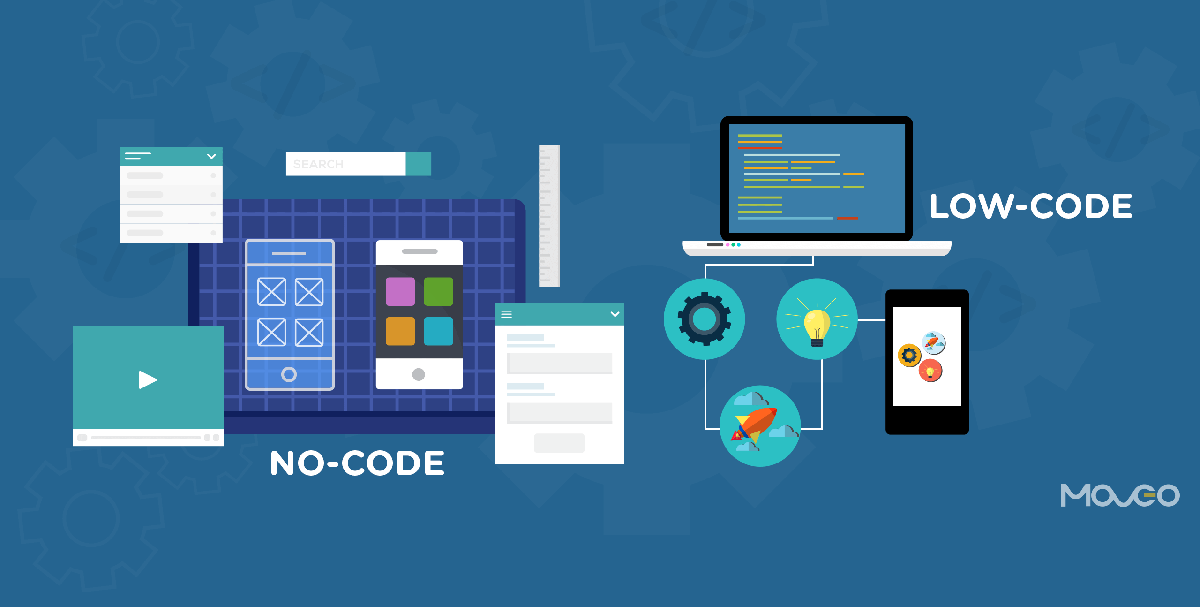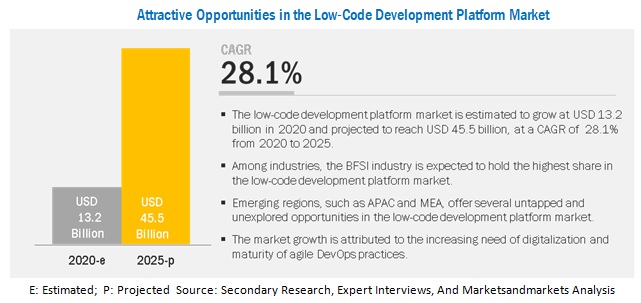Great Ideas On Deciding On Legacy application modernization with Low-code
Great Ideas On Deciding On Legacy application modernization with Low-code
Blog Article
The Benefits Of Low-Code Programming For Application Development As It Relates To Integration Capabilities
Low-code development of apps has numerous benefits, especially in terms integration. This is important for creating applications that can seamlessly connect with platforms and services. These are the main benefits: Pre-built Connectors and APIs:
A wide range of connectors available: Low code platforms include a large collection of pre-built connectors to common enterprise systems (e.g. CRM, ERP databases and cloud services). This eases the process of integration with these systems.
API Integration - Many low-code platforms come with API integration, which gives developers easy access to external services or data sources.
Usability:
Drag-and-Drop Integration: Many integration tasks can be completed by using drag-and-drop interfaces. This allows developers and non-developers to design complicated integrations using little or no code.
Visual Workflow Builders : Software to create workflows and data flows that are visually represented help to understand and set up integrations in a much more simple manner.
Standardized Integration Methods:
SOAP and RESTful Services The support for web services standards such as REST and SOAP facilitates easy integration with a variety of different systems.
OData and various Standards: Supporting standards like OData permits easy access to and manipulation of data across different platforms and applications.
Real-Time Data Synchronization:
Real-Time Integrations: Low-code platforms can handle the real-time synchronization between data applications, systems and databases. This ensures that data is up-to-date and consistent across an company.
Event-Driven Architectures: Certain platforms provide event-driven architectures that enable applications to respond in real-time whenever certain events happen, which is crucial for dynamic applications.
Legacy System Integration:
Connecting old and new Systems Low-code platforms typically provide tools to integrate with older systems, which allows organizations to upgrade their IT infrastructure without having to completely revamp existing systems.
Data Migration Tools Built in data-migration tools make it easy to transfer data from older systems to applications that use low-code.
Integration of Third-Party Services:
Cloud Services Integration: Easy scaling and deployment of apps can be achieved through seamless integration of cloud services like AWS, Azure and Google Cloud.
Integration of Business Applications: Lowcode platforms can be used to integrate different business applications, such as Salesforce, SAP, Microsoft Dynamics etc., creating a cohesive workflow that spans different functions of business.
Simplified Data Management:
Data models that are unifying: A few platforms provide low-code support for unified models of data to make data management easier across systems.
Data Connectors are data connectors that have been pre-configured that offer easy access to data sources and permit manipulation.
Security and Compliance
Secure Integrations: Low-code platforms ensure that integrations conform to security protocols and standard safeguarding data while in transport as well as at rest.
These platforms are usually equipped with features that help in ensuring compliance (e.g. HIPAA, GDPR) and give assurance to companies that handle sensitive data.
Extensibility:
Custom Code and Scripts: Low-code platforms are often able to accommodate more complex integrations through the use of scripts and custom code. This allows for greater flexibility without compromising on ease of usage.
Plug-in Ecosystem An ecosystem of extensions and plugins will enhance integration capabilities by allowing users to easily implement new functions as they are needed.
In general low-code development platforms provide powerful integration capabilities that make them an excellent instrument for creating integrated and effective applications. They make it easier for connecting disparate systems, increase the flow of data, and allow companies to make use of existing technologies while incorporating new ones, which results in an integrated and cohesive IT environment. Take a look at the top rated Low-code Platform for application development advice for more info including mobile development platforms, jdbc server, low code development platforms, rapid application design, cross platform mobile app development, cross platform app development, develop web application, app dev platform, database in azure, low code development platforms and more.
Advantages Of Low Code Application Development For Governance And Security
Low-code applications offer a number of advantages when it comes to security and governance. Both are crucial for ensuring that applications are compliant, secure and properly managed throughout their entire life cycle. These are the primary benefits.
Unified Manage Console: Lowcode-based platforms typically offer a management console that allows administrators to supervise and manage applications.
Role-Based Access Control RBAC (RBAC). These systems typically provide robust access control by role, which gives administrators to create and enforce their own access policies. Only authorized users are able to modify or access certain elements of a program.
Compliance and Regulatory Adherence
The advantages of conformity: Many platforms that use low-code are designed to be in line with industry standards. They provide frameworks and tools that ensure applications meet the requirements.
Audit trails and logs: Comprehensive audit trails and logging are usually combined. This lets companies keep track of changes and access, and also ensure the compliance of internal policies as well as external regulations.
Improved Security Measures:
Data Encryption : Low-code platform usually provide data encryption built-in at rest and during transit. This ensures that sensitive information will be protected.
Security Certifications: A lot of low-code providers have security certifications (e.g., ISO 27001, SOC 2) that demonstrate adherence to high security standards, offering additional assurance to users.
Automated Security Updates
Regularly scheduled updates and patches Low-code platforms generally manage regular patches and security updates automatically, making sure applications are safe from most recent threats, without the need for developer intervention manually.
Security Monitoring Tools: These tools send alerts in real time and insights into security concerns that might be present.
Data Governance
Data Access Policies: These tools permit companies to establish as well as enforce and monitor data policies. This helps ensure that data are only accessible by authorized users and used correctly.
Data Masking and anonymization: Built-in tools for data masking and anonymization can help safeguard sensitive information, especially in the testing and development environment.
Consistent Management of the lifecycle of an application
Pipelines for development and delivery: Low-code platform often include integrated development pipelines and delivery pipelines that incorporate security tests. Security is assured throughout the lifecycle.
Version Control: Integrated version control allows for the management of changes and ensures that any changes to the application are tracked and reverted if necessary while ensuring the integrity of the application.
User Authentication and Authorization:
Single Sign-On (SSO). Support for advanced authentication and single sign-on makes it easier and enhances security.
Multi-Factor Authentication Most platforms allow multi-factor Authentication which provides an additional layer of security when logging into applications.
Compliance Monitoring and Policy Enforcement Compliance Monitoring:
Low-code platforms are usually already pre-defined with templates for policies to help organizations implement governance and security policies quickly.
Compliance Monitoring Tools - These instruments permit continuous checking of compliance status and provide the ability to report, making it easier to spot and fix any issues that might arise.
Integration with Existing Security Infrastructure
Seamless Integration: Platforms that use low-code have been designed to seamlessly integrate with tools and infrastructure, such as SIEM (Security Information and Event Management solutions) and firewalls.
API Security API Security Features: Built-in API security functions ensure that integrations with other systems are secure, protecting information and ensuring the integrity of the application.
Training and best Practices
Guided best practices: Many platforms include guidelines and recommended procedures for the creation of secure applications. They assist non-developers in meeting security requirements.
Security Training: Certain low-code providers provide security training and resources that help users understand how to create and maintain secure applications.
All in all, low-code app developers offer security and governance benefit that enables them to develop and manage their apps in a controlled, regulated and secure manner. These platforms offer the tools and frameworks needed to protect sensitive information, enforce policies and maintain regulatory compliance while simplifying management and oversight. Read the recommended Legacy application modernization with Low-code for website recommendations including develop web app, cross platform app development, driver jdbc, database in azure, application modernization, develop web application, azure sql databases, lowcode no code, jdbc server, cross platform mobile app development and more.
Low-Code Software Can Be Beneficial In Terms Of Collaboration And Workflow
It's a great option for businesses that want to improve team efficiency as well as streamline processes and enhance collaboration. Here are a few of the main benefits: Improved cross-functional collaboration:
Unified Development Environment Low-code platform provides an all-in-one environment which allows all the employees, including developers, analysts design, stakeholders, and others, can effectively work together. This eliminates barriers.
Visual Development Tools - The drag-and drop visual nature of low code platforms allows people who are not technical to take part in the process. This makes sure that all requirements of the business are accurately analyzed and implemented.
Communication Enhancement:
Real-Time Collaboration: Many low-code platforms have real-time collaboration capabilities, such as the simultaneous editing of comments, and instant feedback. These features enable continuous communication and cut down on the time spent on back-and-forth conversations.
Shared workspaces. Teams are able to collaborate on shared workspaces. In this workspace, they can see, edit, and talk about various project components.
A streamlined workflow management system:
Project management tools built-in: Low-code platforms are often equipped with project management tools that allow teams to organize, track and manage their projects. This includes task management, progress tracking and deadline management.
Automation of routine workflows and activities can reduce mistakes and manual labor which allows teams and individuals to concentrate on important initiatives and boost efficiency.
Speedier iteration cycles:
Rapid Prototyping: Low-code platforms allow quick prototyping and iterative development that allow teams to design prototypes, test, and refine applications over shorter periods of time. This allows feedback to be rapidly implemented, and changes can be made.
Support for Agile Methodologies: Using agile methodologies allows teams to be agile and work in sprints, and to continuously provide small amounts of functionalities which makes it simpler to adjust to changing requirements.
Accessibility for non-developers
Citizen Development: Low-code platforms give business users the capability to develop and modify applications without coding expertise. This makes it easier for IT teams and developers, allowing them to react more quickly to business needs.
Training and onboarding: Simple user interfaces and comprehensive training materials make it easier to bring new team members up to level. This enhances overall team's collaboration.
Centralized Documentation, Knowledge Sharing and Information Sharing
Integrated Documentation: Low-code platforms often include features to create and maintain documents within the platform making sure that all information about projects is accessible and centrally stored.
Knowledge Repositories: Teams can develop and maintain knowledge repositories that include best practices, templates, and reusable components, which aid in knowledge sharing and reducing repetition of efforts.
Consistency and uniformity:
Standardized components: A standardized, pre-built component ensures the consistency of the applications. Team members can understand and work with greater ease on different parts.
Governance and Compliance: Built-in governance structures ensure that every development adheres to regulatory standards and organizational standards which reduces the risk of non-compliance and ensuring that applications meet the quality standards.
Feedback and Improvement Loops:
Integrated Feedback Low-code platforms offer users with integrated feedback mechanisms that allow them to provide easy feedback on applications. Feedback from users can used in the development process.
Continuous Improvement: The capacity to rapidly iterate, deploy and change applications based on user feedback allows them to be aligned with the business objectives and user demands.
Visualization, Reporting and Analysis:
Real-time analytics: Built-in analytical and reporting tools provide real-time information about project progress, performances and user interaction. They allow an informed, data-driven decision-making.
Visual Workflow Mapping: Visual tools used to map workflows can be used by teams to enhance workflows. This allows them to identify bottlenecks and areas for improvement.
Low-code app development offers many benefits for collaboration and workflow. This includes the ability to bring teams from different backgrounds into one location, improve communication, and automate certain processes. This promotes a more agile, efficient and collaborative environment for development. This eventually leads to better quality applications and better alignment with business goals.